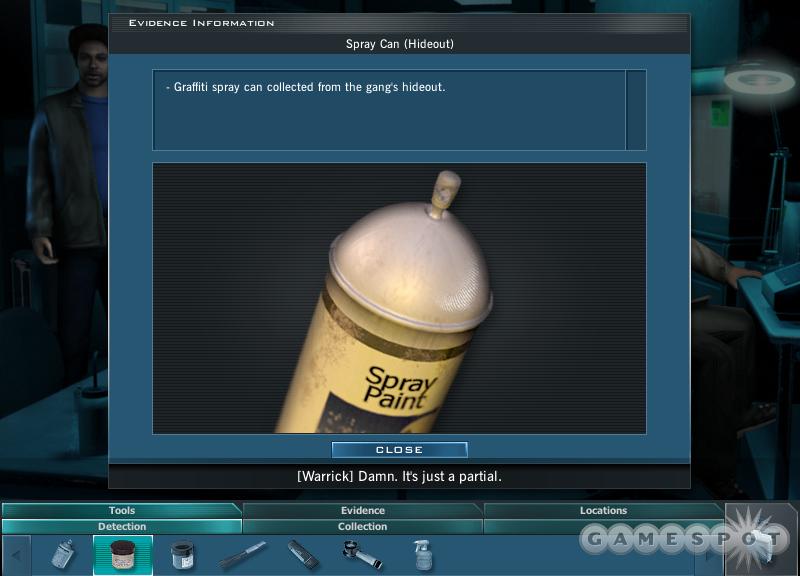Almost a year to the day after Ubisoft released its first PC adventure game based on Jerry Bruckheimer and CBS' wildly popular crime-solving TV series, CSI: Crime Scene Investigation, the company has churned out a sequel in CSI: Crime Scene Investigation: Dark Motives. Similar in design to VU Games' Law & Order games, the first CSI title focused simply on giving the player the chance to investigate and solve crimes that were comparably designed to the kinds of mysteries you'd see on the show--though perhaps a bit too simply. In fact, the first CSI game was almost entirely devoid of challenge and basically just walked you through the motions of gathering evidence, effectively holding your hand through any portion of the game that might require critical thinking. Dark Motives is a lot like its predecessor in most every fundamental way, though with a bit more in terms of challenge and a bit less in terms of hand-holding. Still, serious adventure gamers will find little use for Dark Motives, though serious fans of the TV show will likely take something positive away from it.

Dark Motives presents you with five different mysteries to solve over the course of the game. As it starts out, you are once again a new recruit of the Las Vegas CSI unit, and it is your job to pair up with one of the many familiar CSIs from the show in order to solve these heinous crimes through technologically advanced methods of evidence gathering and analysis. Each of the game's mysteries is pretty unique and well written, and they range from investigating the cause of a motorcycle stunt gone wrong, to solving the murder of a nameless transient, whose body has been dumped in an abandoned insane asylum. As you gather your evidence and begin to put together a picture of what exactly happened, the game will provide you with CG-based reconstructions of possible scenarios for the crime, as well as some rather gruesome anatomical depictions of the horrible things being done to the crime's victim, à la the TV show. The game certainly earns its M rating through some of these reconstructions and a few rather risqué plot points and offhand jokes. Overall, the game does emulate the show quite well, and true fans of CSI will likely get a kick out of the experience.
Dark Motives' gameplay relies on pretty much exactly the same method of crime solving as its predecessor. In each location, you start out with a specific area in which you can investigate. When you move the mouse cursor over certain sections, the cursor turns green, indicating you can investigate further. Often these locations yield evidence or at least something noteworthy to your case for future reference. At your disposal, you have a wide array of detection and collection tools, such as a UV light to detect hidden stains and bruises and varying types of fingerprint detectors for different types of surfaces. All of your evidence eventually finds its way to the crime lab, where it is analyzed or put into the computer or under a microscope for your own analysis. You can cross-reference prints against the police database, compare different samples of hair, or compare tire tracks against one another. All told, there's definitely more for you to do in Dark Motives than in the last game, and the game is better about letting you take care of matters rather than simply doing everything for you. Unfortunately, there still isn't much challenge to the game as a whole.
For the most part, each mystery's progression of gathering evidence, interviewing suspects, and eventually acquiring warrants and conducting interrogations is quite straightforward. If by some chance you do get stuck, it's probably because you've simply overlooked an obscure piece of evidence somewhere. Though these pieces are rarely obvious by themselves, you can easily narrow down where exactly to look simply by asking your current partner for help; or, to be more precise, you can ask your partner if you can ask a question, and then you can just look at the title of the question you want to ask. Actually asking questions docks points from your evaluation at the end of a mission, but the titles of the questions, such as "How can I find out more about the origin of the wheelchair?" pretty much tip you off as to what exactly you're missing, and you don't actually have to ask a question. Additionally, once you get a feel for how the game's pacing and design work, the last few missions become almost sadly easy, as it's just plain obvious what it is you're supposed to do and how you're supposed to go about doing it.
Dark Motives, like last year's title, is a fairly modest game in terms of length. Each mystery will take you anywhere from 45 minutes to an hour, and the game overall shouldn't take you more than five hours to finish. Of course, there is the added bonus of theoretically trying to go back and get a perfect score on every mission, but surprisingly enough, even with every helper turned on and even after asking several questions to our partner, we never completed a mission without getting the highest ranking, and we unlocked every single extra item on the first try. Whether this is a bug or just an insanely easy game design, we will likely never know. One issue that is definitely bug-related is that the game isn't entirely stable. On a high-end PC, there were times when loading missions would cause the game to crash to the desktop, and occasionally, extended play sessions would simply cause all the text from the game's menus to disappear. These issues were infrequent but were still odd considering how light the game's hardware requirements are. There are some other quirks here and there--for instance, occasionally the game will allow you to get ahead of the plot, providing you with questions and answers to scenarios you haven't experienced yet--but as with the stability issues, these are few and far between for the most part.

The big draw for Dark Motives is that it features the full range of voice talent and appropriate character likenesses from the TV show. Last year's game was rather disappointing when it came to visuals, but Dark Motives does provide somewhat of an upgrade. The models for each of the game's characters are much better, and they look and move more naturally, though the lip movements as the characters speak to you are still pretty badly synced. The environments look a bit less fake and a tad more interactive in Dark Motives, though it's still plainly obvious when an object is something you should be looking at, as it's significantly brighter than the background that surrounds it. The entire cast of CSI is on hand for voice work in Dark Motives, including William Petersen, Marg Helgenberger, Paul Guilfoyle, and Jorja Fox. The range in terms of how well these actors translate their roles to a voice-acting capacity is erratic. Some, such as Fox, seem to relish the experience and really make their characters come alive. Others, like Petersen, seem bored stiff and serve only to make their portions of the game less interesting. The remaining portions of the game's audio are pretty well done, including some great-sounding background music and similarly excellent sound effects.
Though Dark Motives is definitely a much-improved game over last year's effort, its appeal still remains elusive to all but the most vehement fans of the TV series. This is not a game that typical adventure game fans will get much out of, simply because it isn't designed with them in mind. This is a game designed specifically for a general audience, and thus, the bulk of what would normally make an adventure game challenging or unique has been stripped away in favor of the most user-friendly interface and game design possible. If you are a fan of the show, then this likely won't bother you, and you'll be able to more easily forgive the game's merely average gameplay and more readily appreciate how well the game mimics the style of the show. For anyone else, Dark Motives probably won't do much for you, and it is probably best left on the shelf.